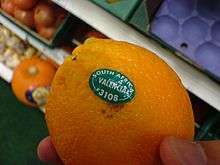Valencia orange
| Valencia orange | |
|---|---|
 Valencia orange | |
| Species | Citrus × sinensis |
| Hybrid parentage | pummelo x mandarin orange |
| Cultivar | 'Valencia' |
| Breeder | William Wolfskill |
| Origin | Santa Ana, California United States |
The Valencia orange is a sweet orange. It was first hybridized by pioneer American agronomist and land developer William Wolfskill in the mid-19th century on his farm in Santa Ana, southern California, United States, North America.[1]
History

William Wolfskill (1798–1866) was an American born in Kentucky and reared in Missouri. He became a Mexican citizen in the 1820s, when in his 20s, while working in Santa Fe, New Mexico as a fur trapper, and then migrating to California, which was still Mexican at the time. He was given a land grant as a naturalized Mexican citizen under Mexican government rules. He cultivated numerous vineyards and grape varietals, and was the largest wine producer in the region. He continued to buy land, and later had sheep ranches, as well as developing extensive citrus orchards. He hybridized the Valencia orange, a sweet orange, naming it for Valencia, Spain, which had a reputation for its sweet orange trees. These had originally been imported from India.
Before his death in 1866, Wolfskill sold his patented Valencia hybrid to the Irvine Ranch owners, who planted nearly half their lands to its cultivation. The success of this crop in Southern California led to the naming of Valencia, California. It became the most popular juice orange in the United States.
In the mid 20th century, Florida botanist Lena B. Smithers Hughes introduced major improvements to the Valencia orange, developing virus-free strains for budwood production. These were so successful that, by 1983, the Hughes Valencia bud line made up some 60 percent of all Valencia oranges propagated for cultivation in Florida.[2]
In 1988, Merleen Smith, a woman in Ventura County, California, contacted her local farm advisor on the suspicion that her neighbor was poisoning her tree. Investigators found that it was a pigmented bud sport of a conventional Valencia orange tree. The orange cultivar 'Smith Red Valencia' (with red insides) now bears her name.[3]
Description
Primarily grown for processing and orange juice production, Valencia oranges have seeds, varying in number from zero to nine per fruit. Its excellent taste and internal color make it desirable for the fresh fruit markets, too. The fruit has an average diameter of 2.7 to 3 inches (69 to 76 mm; 6.9 to 7.6 cm), and a piece of this fruit which weighs 96 grams (3.4 oz) has 45 calories and 9 grams of sugar.[4] After bloom, it usually carries two crops on the tree, the old and the new. The commercial harvest season in Florida runs from March to June. Worldwide, Valencia oranges are prized as the only variety of orange in season during summer. Furthermore, Valencia oranges bring benefits because of the vitamin C and flavonoids contained.[5]
In 2012, the genome of the orange was found, with 29,445 protein-coding genes. It also found that the sweet orange originated from a backcross hybrid between pummelo and mandarin orange.[6]
See also
References
- ↑ "Valencia oranges". Citrus Trees Online. Retrieved 2012-06-21.
- ↑ Jean, Charlie (1987-12-21). "Lena Hughes, Orange Tree Researcher, Dies". Orlando Sentinel, 21 December 1987. Retrieved from http://articles.orlandosentinel.com/1987-12-21/news/0170070087_1_valencia-university-of-florida-college-in-lakeland.
- ↑ "Orange – Smith Red Valencia". gardenamerica.com. Retrieved 2017-01-12.
- ↑ "Orange juice calories". Oranges Online. 2014-12-17. Retrieved 2014-12-12.
- ↑ "The orange: an important source in vitamin C". Naranjas Quique. Retrieved 2015-06-25.
- ↑ Xu, Qiang; Chen, Ling-Ling; Ruan, Xiaoan; et al. (2012-11-25). "The draft genome of sweet orange (Citrus sinensis)". Nature Genetics. 45 (1): 59–66. doi:10.1038/ng.2472. PMID 23179022.
External links
- HOME FRUIT PRODUCTION-ORANGES at Texas Cooperative Extension Texas A&M Horticulture program
- Sweet Oranges (including Valencia Oranges: Campbell Valencia orange, Cutter Valencia orange, Delta Valencia orange, Midknight Valencia orange, Olinda Valencia orange at University of California Riverside Citrus Variety Collection
- Budget Plants: Valencia Orange Tree Information